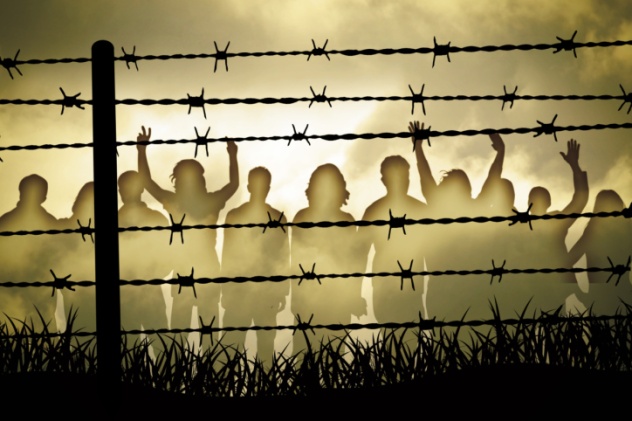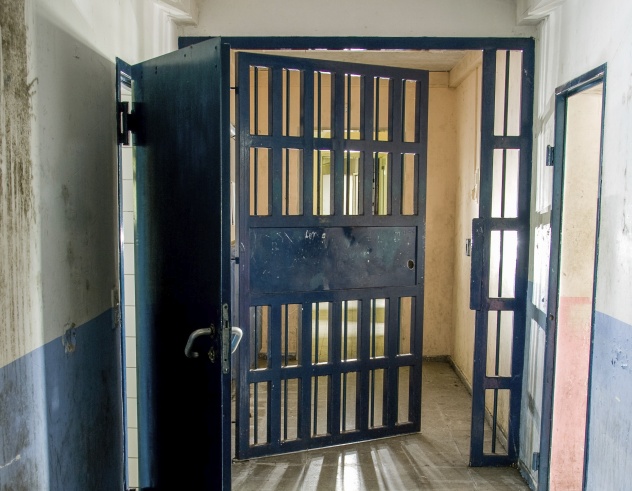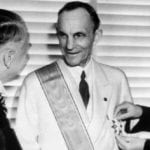SEE ALSO: 10 Conspiracy Theories About MK-ULTRA You May Not Know
10 Paul Bennewitz
In the 1980s, Paul Bennewitz owned a humidity equipment company that had a number of contracts with Kirkland Air Force Base in Albuquerque, New Mexico. Bennewitz lived near the base and said he saw UFOs flying over it. According to special agent Richard Doty of the US Air Force Office of Special Investigations, and backed up by documents discovered using the Freedom of Information Act, Bennewitz was actually encouraged to believe that he saw real UFOs. Doty met with Bennewitz a number of times and passed him false documents. The false documents seemed to indicate that there was going to be an alien invasion, and it could happen at any time. Since Bennewitz was convinced that the government was hiding an imminent alien invasion that, of course, never happened, he spent one month institutionalized for paranoia. Doty fed Bennewitz the false information to discredit him. What he actually saw was a secret helicopter training program. By convincing Bennewitz that what he saw was a UFO, it would make him look crazy, and no one would believe anything he said.
9 Christopher Kirkpatrick
Whistle-blowers are in an unusual position when it comes to the government. In the private sector, whistle-blowers can turn to the government for help, but to whom do government whistle-blowers turn? One notable example how troublesome this problem can be is the case of 38-year-old clinical psychologist Christopher Kirkpatrick. Kirkpatrick got a job one month after finishing his doctorate in August 2008, with the Tomah Veterans Affairs Medical Center in Wisconsin. His job was to work with soldiers suffering from post-traumatic stress disorder. Kirkpatrick’s treatment involved giving people therapy and having his patients do activities like yoga. Other doctors at the medical center didn’t agree with Kirkpatrick’s approach and chose to prescribe opiates to patients instead. However, these prescriptions were affecting Kirkpatrick’s treatment and he thought the patients were being overmedicated. Kirkpatrick found the overmedicating troublesome and brought it up in an early 2009 meeting with the health care providers. At the meeting, there was a physician’s assistant who had been overmedicating. The physician’s assistant spoke to the faculty’s chief of staff, and Kirkpatrick was written up for criticizing the physician’s assistant. Kirkpatrick wanted to pursue the overmedicating issue but was told to stay quiet and that he should just pay attention to his own work. Three months later, in July 2009, Kirkpatrick had a disturbing run-in with a patient who threatened to hurt him and his dog, which he had brought to work. He took off the next two workdays, which were a Friday and a Monday, to clear his head and get right mentally. When he returned to work on Tuesday, he was fired. Apparently, he left one hour early, logged a 90-minute leave incorrectly, wasn’t supposed to take days off on Mondays or Fridays, and someone had to clean up after his dog once. Kirkpatrick pleaded for another chance; he was trying very hard and had moved away from his family and his girlfriend for the job. He said that he made mistakes, but it was an incredibly stressful job, and he was still trying to work out all the kinks in his treatment. His pleas fell on deaf ears, and Kirkpatrick left the meeting defeated. That night, Kirkpatrick went home, stuck a gun under his chin, and shot himself. After his suicide, new laws were implemented to help whistle-blowers within Veterans Affairs. Health officials also investigated the Tomah VA after a patient died from “mixed drug toxicity” in August 2009. They concluded that the Tomah VA was indeed overmedicating their patients. Compared to the national average, the patients at Tomah VA were two and half times more likely to get higher doses of opiates.
8 Iranian And Iraqi Refugees In Australia
In 2001, the Australian government made some drastic changes to the country’s migration act. This was part of their tough stance against illegal immigration. At the time, Human Rights Watch and the US Committee for Refugees wrote a letter to Prime Minster John Howard condemning the changes, saying that they were cruel. The changes involved what would happen when refugees arrived in Australia. Generally, one of two things would happen: They would either be put into a detention center, or they were granted three years of temporary refugee status. In 2005, a study from the University of New South Wales on the treatment of the refugees looked at three different groups of refugees, all from Iraq and Iran. They found that refugees who were in detention centers or were granted temporary refugee status had high levels of mental illness, but those given permanent refugee status had low levels of mental illness. It is believed that the uncertainty of their future took a toll so terrible that it was twice as mentally destructive as the trauma they were running from.
7 Sam Mandez
Not too long ago, we looked at how devastating solitary confinement can be. A notable case is that of Sam Mandez. Mandez was imprisoned at the age of 18 for a murder he supposedly committed on July 26, 1992, when he was 14 years old. The only real piece of evidence against him was his fingerprints on a window of the murder victim’s house. However, he explained that he had been in the house because he had painted it with his uncle the year before the murder. He also had an alibi for the night of the murder. Nevertheless, he was tried as an adult. This is where Colorado’s laws really doomed Mandez. For example, the prosecutor didn’t introduce key evidence because they did not have to introduce evidence if it helps exonerate the person they’re prosecuting. Also, the defense wasn’t allowed to cross-examine the police about the fingerprints on the window. Based on the evidence, and the instructions from the judge, Mandez was found guilty by a jury that originally voted six to six before eventually coming to a unanimous guilty verdict. One juror told the defense to appeal, while another juror later said that they felt compelled to vote that way because of the way the laws in Colorado worked. Since Mandez was convicted of felony murder, he was given an automatic sentence of life in prison without possibility of parole. Mandez was sent to prison, and in 1998, after about two years inside, he was put into solitary confinement for very tiny infractions. For example, he made a three-way phone call, and he wasn’t supposed to do that. Once he was put in solitary confinement, he never really left. He would spend 16 years there, and his mind completely deteriorated over the years. Since 2010, at least eight different psychiatrists have treated Mandez, and all of them have classified him as seriously mentally ill. Mandez was a mentally healthy young man before his incarceration. Because of his mental illness, which includes schizoaffective disorder, major depressive disorder with psychotic features, and schizophrenia, Mandez suffers from a number of delusions. For example, he believes he’s married to Dog the Bounty Hunter’s daughter, and he has 11 children. He also has been a Green Beret since the age of 12, and he was an architect for the Denver International Airport. State officials justify their actions by saying that Mandez needs to be put in solitary confinement because he has frequent outbursts due to his mental illness.
6 Alvin Ford
Alvin Ford was arrested and convicted of murdering a police officer during a robbery at a restaurant on July 21, 1974, in Fort Lauderdale, Florida. He was sentenced to death and sent to death row at the Florida State Prison. During that time, other people around him were executed, and he came within 14 hours of his own death in 1981. His lawyers claimed that these conditions drove him insane. For example, he believed he was Pope John Paul II and that he communicated with UFOs. His lawyers had two written examinations from doctors which said that Ford was a paranoid schizophrenic and wasn’t competent to be executed. Prisoners are not to be executed if they are insane or do not understand their own impending death, because they are supposed to make their final peace and be able to help in their own appeals. So, in 1983, his lawyers appealed, and his case went to the Supreme Court. With just 12 hours to go before his execution in 1984, a delay was ordered by the court. In total, his case was heard five times by the Florida Supreme Court and four times by the United States Supreme Court. His last ruling was in 1989, a judge ruled that he was sane, and his lawyers were appealing when he died on February 26, 1991, at the age of 37, from respiratory problems.
5 Abu Zubaydah
In 2004, it was first revealed that some prisoners were being tortured at the Guantanamo Bay detention center in Cuba. At first, the United States government denied this, but they later admitted to performing “enhanced interrogation techniques” on high-value detainees. One of the most notable people who were driven mad from these conditions is a man named Abu Zubaydah, who is a suspected Palestinian terrorist. He was captured during a March 2002 raid in Pakistan. He was hit by a bullet during the raid and was on a breathing tube. During his recovery, he said he wanted to help the US government. The CIA responded by torturing him. In Thailand, at a US compound called Detention Site Green, Zubaydah was put in isolation for 47 days. Afterward, they questioned him using enhanced interrogation techniques for 20 days straight. During that time, he was waterboarded 83 times over a 17-day period. Zubaydah also watched as they brought a coffin-like box into the interrogation room. Out of the 20 days, Zubaydah would spend a total of 266 hours in the coffin-like box. What’s horrifying is that by the sixth day, the interrogators knew that he probably didn’t have any information that would be valuable to the CIA. In fact, at least one analyst realized he had gone insane. Yet the interrogation carried on for another two weeks. After being mentally broken, Zubaydah was shipped from detention center to detention center until 2006, when he ended up at Gitmo. He currently resides in Camp 7, which is the most secure section of the center. His lawyer says that he already had some mental issues from fighting communists in Afghanistan, activity that was backed by the United States government, but his mental health problems have been exacerbated by the enhanced interrogation techniques. Zubaydah has blinding headaches and is sensitive to light and noise. He is also losing his memory; he doesn’t remember what his mother looks like, and he can’t remember his father’s name. Zubaydah is considered to be the guinea pig for the enhanced interrogation techniques that were infamously used at Gitmo.
4 Iwao Hakamada
Death row in Japan is a little bit different than many other death rows in the world. One major difference is that prisoners do not know when they will be hanged. They are told only hours before they are set to die, meaning that any day on death row could be an inmate’s last. In addition to the threat of death hanging over their head every day, they also spend most of their time in isolation and are given very little exercise. According to Amnesty International, these conditions have created an environment where mental illness has become a major problem. One example of the problematic nature of the situation is Iwao Hakamada. The former boxer was sentenced to death in September 1968, after his boss, his boss’s wife, and their two children were murdered, and Hakamada was charged with the murders. The case was a bit shaky, and Hakamada claimed that the police beat a confession out of him. Nevertheless, he was found guilty and sentenced to death. Hakamada sat in solitary confinement on death row for over 45 years, knowing that he could be hanged any day. In fact, he was on death row for so long that the Guinness Book of World Records says that he has spent more time on death row than anyone else. Due to all that time alone, Hakamada’s mental state has deteriorated drastically, and he was diagnosed with “institutional psychosis.” In March 2014, a retrial was ordered over DNA evidence, and Hakamada was released until his new trial.
3 Yu Dongyue
In May 1989, during a pro-democracy rally in Tiananmen Square in Beijing, China, Yu Dongyue, a newspaper journalist and government critic, as well as two other men, threw eggs filled with red paint at a painting of Chairman Mao. They were arrested, and Dongyue was given the harshest punishment of all three men—20 years in prison. While in prison, Dongyue was subject to extensive torture, including being tied to an electrical pole out in the sunlight for a few days. However, his friends and family believe that spending two years in solitary confinement is what caused his mental breakdown. Since his imprisonment, human rights groups have urged the Chinese government to release him, and lawyers were successful in shaving three years off his sentence. After 17 years in prison for vandalizing a painting, Dongyue was released from prison on February 22, 2006. When he was released from prison, he didn’t recognize any of his family members, and when he spoke, it was unintelligible. In 2009, Dongyue was given political asylum in the United States, and he and his sister moved to Indianapolis. In the US, he spends most of this time at the spa where his sister works, but he has a tendency to wander off and go missing. In one incident when he wandered off, he was arrested for public intoxication due to his diminished mental capacity, and he was booked under the name “Jackie Chan.”
2 Citizens Of South Hwanghae, North Korea
There are a number of ways that someone can go mad. If the body is desperate enough, then the mind will stop working properly and do things that a sane person would never think of. A terrifying example of this comes from reports coming out of South Hwanghae, North Korea, in January 2013. According to citizen reporters who spoke to the Asia Press, there was a famine going on in the area that affected a number of people. This included a grandfather who dug up his grandchild for food. Another report said that a father, driven mad by hunger, killed his eldest daughter in order to cook her. However, his son saw the murder, so he killed the son as well. When his wife got home, he told her that they had meat, but she was suspicious and didn’t eat the meat. She found the bodies of her children near their home. The father was executed by a firing squad. North Korea, as usual, did not deny or confirm if the secret famine was happening.
1 Gary Webb
Gary Webb was a Pulitzer Prize–winning investigative reporter who started working at the San Jose Mercury News in 1988. In August 1996, Webb broke a major story, and it was one of the first stories to go viral on the Internet. In his 20,000-word, three-part series called Dark Alliance, he accused the CIA of turning a blind eye to crack cocaine being trafficked into the United States from Nicaragua in the 1980s. The reason they allowed it was because the money was buying arms to support the contras in Nicaragua that wanted to overthrow the leftist Sandinista government, which is what the CIA wanted. Webb’s claim was highly controversial: In order to win a proxy war, the CIA had allowed crack cocaine to flood mostly black urban communities during the crack cocaine epidemic. The news was a huge story when it broke, and the CIA knew it was a public relations nightmare. Interestingly enough, they didn’t have to actively discredit him. The CIA simply did not confirm anything that Webb wrote but did confirm any story that undermined Webb’s accusations. And there were plenty of reporters who tried to discredit Webb. Many newspapers, especially the Los Angeles Times, felt burned that Webb had broken the story. They printed anything that might go against the story, and Webb ended up being fired in disgrace. Things got so bad for Webb that, despite being a Pulitzer Prize–winner, he could only get a part-time job at a small, weekly newspaper. Besides his credibility and his job, he also lost his friends and his family. Webb committed suicide on December 10, 2004. It was later proved that Webb was right. The CIA did allow crack cocaine to be imported into the United States. Webb’s story was made into the 2014 movie Kill the Messenger, with Jeremy Renner in the role of Webb. Robert Grimminck is a Canadian freelance writer. You can friend him on Facebook, follow him on Twitter, or visit his website.
























